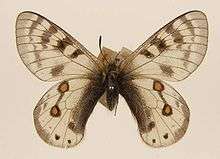Parnassius staudingeri hunza
| Karakoram banded Apollo | |
|---|---|
 | |
| Scientific classification | |
| Kingdom: | Animalia |
| Phylum: | Arthropoda |
| Class: | Insecta |
| Order: | Lepidoptera |
| Family: | Papilionidae |
| Genus: | Parnassius |
| Species: | P. staudingeri |
| Subspecies: | P. s. hunza |
| Trinomial name | |
| Parnassius staudingeri hunza Grumm-Grshimailo, 1888 | |
Parnassius staudingeri hunza, the Karakoram banded Apollo, is a high-altitude butterfly which is found in India. It is a member of the genus Parnassius of the swallowtail family, Papilionidae. It was variously treated as a subspecies of P. delphius and a distinct species.
Description

Male upperside ground colour duller, more sullied white. Forewing: the discal band in typical specimens very much shorter, not extended below vein 5, but in all specimens observed, the discal band reaches vein 1, and where it crosses interspace 3 is joined onto the postdiscal transverse band by a broad cross-bar, that extends right up to the base of that interspace. Hindwing: the sub-terminal series of dark spots reduced to one or two near the tornus, the anterior spots (except the spot in interspace 7) replaced by a curved band of somewhat luuulur spots that extends unbroken between the spot in interspace 3 and that in interspace 7. Underside: similar to the underside in Parnassius stoliczkanus, with no red spots at the base of the hindwing; in a few specimens a discal and a subcostal black-encircled red spot are present. Antennae, head, thorax and abdomen as in stoliczkanus.[1]
Range
It is seen in Afghanistan, Pakistan, northern India (including Jammu and Kashmir, Himachal Pradesh and Uttarakhand), western China (?), Tibet (?).
Status
It is widely distributed. Locally common, generally rare. Not known to be threatened. Requires further research. This butterfly is protected by law in India and was featured in the erstwhile USSR Red Data Book as being vulnerable.
See also
Cited references
- ↑ Bingham, C.T. (1907). The Fauna of British India, Including Ceylon and Burma. II (1st ed.). London: Taylor and Francis, Ltd.
Other references
- Collins, N. Mark; Morris, Michael G. (1985). Threatened Swallowtail Butterflies of the World: The IUCN Red Data Book. Gland & Cambridge: IUCN. ISBN 978-2-88032-603-6 – via Biodiversity Heritage Library.
- Evans, W.H. (1932). The Identification of Indian Butterflies (2nd ed.). Mumbai, India: Bombay Natural History Society.
- Haribal, Meena (1992). The Butterflies of Sikkim Himalaya and Their Natural History. Gangtok, Sikkim, India: Sikkim Nature Conservation Foundation.
- Wynter-Blyth, Mark Alexander (1957). Butterflies of the Indian Region. Bombay, India: Bombay Natural History Society. ISBN 978-8170192329.
- Sakai S., Inaoka S., Toshiaki A., Yamaguchi S., Watanabe Y., (2002) The Parnassiology. The Parnassius Butterflies, A Study in Evolution, Kodansha, Japan. ISBN 4-06-124051-X
- Weiss Jean-Claude, (1999) Parnassiinae of the World, Hillside Books, Canterbury, UK. ISBN 0-9532240-2-3, OCLC 41072974
| Wikimedia Commons has media related to Parnassius staudingeri. |